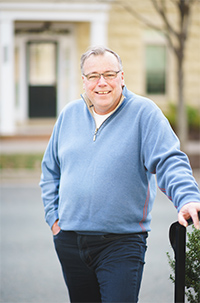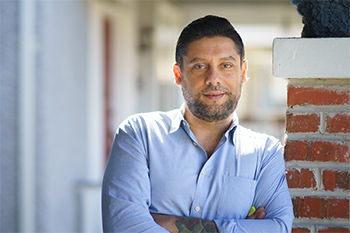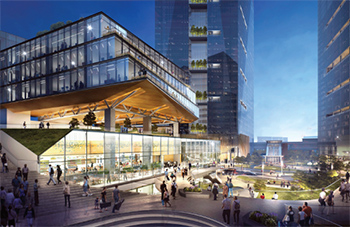Changing times
A demographic revolution is transforming how Virginians live — and vote
Changing times
A demographic revolution is transforming how Virginians live — and vote
Town houses and apartments, storefronts and restaurants, grassy medians, pocket parks, sidewalks everywhere. Doesn’t this look a lot like a downtown?
Picking up his mail in slippers and shorts on a brisk January day, Tandy Harris pauses to consider the question. “It does,” he agrees. “It’s got all the bells and whistles.”
That’s one reason the human resources executive for a digital marketing firm decided four years ago to buy a four-bedroom town home in West Broad Village, a “new urban” housing and retail development in suburban Henrico County’s Short Pump area.
Harris likes having no yard to mow and rake. He can walk to a locally owned burger joint, a cozy British-style pub, a Whole Foods or Trader Joe’s. He can get a haircut or visit a dentist, all without getting into a car. Since he commutes to New York City half the month, he likes how close his home is to an Amtrak station.
Not too long ago, you’d need to be in a city to have a lifestyle like this. No longer. Increasingly, pseudo-downtowns like the one where Harris lives are popping up in suburbs all across Virginia — particularly near major hubs like Washington, D.C., Hampton Roads and Richmond.
This is no coincidence. It’s happening for the same reasons Virginia’s downtowns suddenly are packed with millennials, why it’s easy to find good Thai food, and why the past two elections turned the once-red commonwealth distinctly purple: the unstoppable tide of demographics.
For businesses ranging from giant real-estate and retail developments to local merchants, knowing who and where their customers are in this changed Virginia could spell the difference between winning and losing.
Virginia is “in the middle of a long-term realignment,” says Rachel Bitecofer, assistant director of the Wason Center for Public Policy at Christopher Newport University. “It is going to have big ramifications.”

Shifting center of gravity
Since the last U.S. Census in 2010, Virginia’s population has grown an estimated 6.7%, to
8.5 million, according to the Weldon Cooper Center for Public Service at the University of Virginia. Two-thirds of that growth has taken place in Northern Virginia.
While Northern Virginia has boomed, the population in much of the state has stagnated or shrunk. Outside the top three metro areas, Virginia’s population has grown just 1.3% since 2010, the center reports, with 51 of Virginia’s 95 counties losing residents.
The burgeoning suburbs wrapping around Washington, D.C., tend to be younger — 27% of residents in Northern Virginia are younger than 20 years old, according to the Virginia Department of Health. Compare that with Southwest Virginia, where the rate is 18%.
These communities also are less white — as of 2018, 49.4% of Northern Virginia residents identified as members of a racial minority, up from 36.4% in 2010, according to the Northern Virginia Regional Commission. Additionally, Northern Virginians are more likely to have been born in another country — the four counties and five cities of Northern Virginia boast 27% of the state’s foreign-born population.
Such shifts in Virginia’s population have had clear effects on politics, says Fabrizio Fasulo, director and chief economist at the Center for Urban and Regional Analysis at Virginia Commonwealth University’s L. Douglas Wilder School of Government and Public Affairs.
With a larger, younger and more racially and ethnically diverse population than the rest of the state — all qualities strongly affiliated with Democratic voters — Northern Virginia tends to vote blue. The region also contains a higher rate of people with college educations, who over the last quarter-century also have leaned increasingly toward Democrats.
This explains why Democrats have wrested complete control of the General Assembly from Republicans for the first time since 1993, Fasulo says.
And not just that. Economists and social scientists like Fasulo say this evolution signals what could be a complete reshaping of what we used to think about the suburbs — what they are, who lives there and what that means for the rest of the state.
Suburbs: the new cities

Many of our suburbs are no longer the stereotypical places where conservative-leaning white people water tidy patches of green grass behind white picket fences.
Today nearly 60% of African Americans live in suburbs, Fasulo points out; almost one-third of the country’s suburban population is composed of African Americans, Asians and Hispanics.
During the next decade, vibrant city centers like Washington, D.C., Richmond and Norfolk will continue to be hubs of economic activity, says Santiago Pinto, senior policy economist in the research department of the Federal Reserve Bank of Richmond.
At the same time, however, “you will be seeing a new wave of suburbanization, with the added impact of a different composition and more minorities,” Pinto says.
Increasingly, the suburbs also are becoming home to younger homeowners. While for the past decade millennials and their Generation Z siblings have moved to city centers, transforming downtowns in the process, cities in Virginia have been seeing signs of this trend slowing down or even declining during the past few years, according to recent research from the Weldon Cooper Center.
Statistics like these suggest to Virginia Realtors Chief Economist Lisa Sturtevant that some proportion of younger adults have moved to the suburbs. Suburban school systems tend to perform better than their urban and rural counterparts, making them a strong attractor for young parents.
But many of those younger residents still want the sense of a downtown, Sturtevant adds. They’re not as enamored of the housing developments that exemplified much of the 20th century, with expansive front yards and sidewalk-free roads leading to megamalls. They want a different sort of suburb, with a variety of housing options, a sense of community, with easy access to public transportation, and parks and retail within walking distance.
Developers and retailers are responding, Sturtevant says. “In the suburbs now, there are more choices, more affordability, more options of all kinds.”
Take the Mosaic District, a $500 million built-from-scratch retail and housing development on 32 acres in Fairfax County. Launched by developer Edens in 2013, the Mosaic aims to recapture the sense of living in a thriving, close-knit community, complete with a local fishmonger, 1-acre park and art-house cinema.
“When people come together routinely … they start to see the same people and to be exposed to the same groups,” Edens CEO Julie W. McLean explained to Leaders Magazine last year. “This creates familiarity and causes them to start to feel like they are a part of the community. That is when we truly see prosperity follow, and that prosperity is economic, social, cultural and soulful.”
Or take a look at the reimagining of another area of Northern Virginia: Tysons, formerly Tysons Corner, in Fairfax County. It’s in the midst of transforming itself from a quintessential office-park-style suburb bookended by giant, roofed-in shopping malls into a walkable, live-shop-and-work community.
Through the 1980s, Tysons was a raging financial success. One 50-year resident called it “the blob that ate Northern Virginia.” It made up the 13th-largest concentration of office space in the nation and contained 100,000 jobs and 17,000 residents. But with few or no sidewalks, it was almost impossible to walk there. It also suffered some of the nation’s worst traffic jams.
By the mid-2000s, Tysons was losing ground to developments in Arlington County offering higher density and more walkability — a downtown feel. After a lengthy review, Fairfax County decided to move forward with a rehaul.
Centered around a $2.9 billion expansion of Metrorail’s Silver Line, this new vision of Tysons’ 2,400 acres adds parks, pedestrian-friendly side streets, bike lanes and mixed housing. By 2040, county planners say, the amount of office space in Tysons will nearly double from 2010, to 45 million square feet, while residential space will almost quintuple, to 50 million square feet.
County officials want Tysons to be a city, says Clemente Development Co. Inc. founder and CEO C. Daniel Clemente. However, “if you want to change Tysons from what it was — an office park and malls — into a city,” he says, then “you have to have a place where people can live and where they can walk to work.”
Clemente’s planned $1.3 billion, 3 million-square-foot development of mixed-use residential, commercial and leisure spaces, The View at Tysons, was approved by the Fairfax County Planning Commission late last year. Its proposed centerpiece, the 600-foot-tall Iconic Tower, is slated to include a cultural center and black-box theater.
Clemente is pushing the county to waive its cash-proffer requirements in return for building The Evolution, a multifamily apartment community, on land his company owns near the Spring Hill Metro Station. All 1,400 units would be priced for workforce housing. “You can’t have people driving in to work in Tysons from Loudoun [County],” Clemente argues. “That would defeat the point.”
The housing question
In many ways, Loudoun exemplifies how demographic shifts are forcing changes in how counties and businesses manage the changing suburbs.
At the northernmost tip of Virginia, Loudoun County for years saw itself bifurcated into two regions: a suburban-style section with modest single-family homes like those in neighboring Fairfax County and a rural one to the west with mansions set among rolling meadows and farms.
In recent years, however, the population of Loudoun has ballooned — from 310,000 in 2010 to about 406,000 in 2018 — and changed, growing younger and more ethnically diverse. Meanwhile, housing stocks have not kept pace. That has resulted in a shortfall of affordable housing, according to a 2018 study by the Loudoun County Economic Development Advisory Commission.

As in most of Northern Virginia, housing in Loudoun costs significantly more than the nation as a whole. In Loudoun, a full-time worker would have to earn at least $32 an hour to afford a two-bedroom apartment, according to a 2019 report by the National Low Income Housing Coalition. That might be much lower than national record holder San Francisco’s $60-an-hour requirement but it’s notably higher than the Virginia average of $23 an hour.
That means many employees of the county’s businesses have to commute long distances, the advisory commission noted. This results in businesses having difficulty hiring and retaining workers.
In response, this January the county enacted a housing plan that would permit 40,950 additional homes by 2040, mostly in suburban sections to the east and planned urban areas around new Metrorail stops. The plan took 3 ½ years to complete, largely due to conflicting ideas and debates about priorities.
“For the first time, there are a lot of other voices in the area,” says Phyllis J. Randall, chair-at-large of the Loudoun County Board of Supervisors and the first African American woman elected to lead a Virginia county board of supervisors. “We are more diverse now — not just ethnically but also diversity of age, of experience, of income.”
Mixed-use suburban development will be key, Randall says. She points to Kincora, a development from Tritec Real Estate Inc. and Norton Scott LLC on 424 acres at the corner of state Routes 7 and 28. Among the development’s planned amenities is a children’s science center. Kincora’s first large multifamily construction, the 333-unit Jameson, is expected to open this year, joining already-built condos and a 96-unit affordable-housing apartment building.
Open questions
These trends are shaping the state, from voting patterns to development plans. But exactly how much remains a mystery — for now. Not until the 2020 Census is complete, experts say, will the full contours be visible of who is living where.
Ever since the 2010 Census, researchers, economists and regional planners have been extrapolating from it and other data to guide their analyses. When this year’s census figures are tallied, they will see how close to the mark their projections have been.
“A lot of people have a lot of expectations riding on this [census],” says the Richmond Fed’s Pinto. “We will want to confirm with hard numbers these trends we have seen.”
But already it is clear that, from legalizing hemp farming to expanding Medicaid to enacting gun-control legislation, these new suburban residents have set in motion changes in the commonwealth that will have effects far beyond their walkable new-urbanist enclaves.
From large-scale developers who need to attract buyers, to retailers aiming to set up storefronts near their customers, how businesses adjust to these new suburbs will make — or break — many of them, experts say.
“You can either lean into a certain kind of climate and make it your friend — or you can fight it,” says CNU’s Bitecofer. “It’s my experience that leaning in is a better strategy.”
l
















